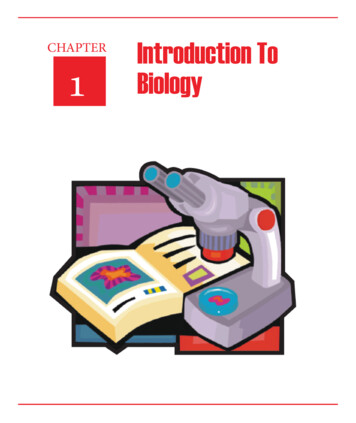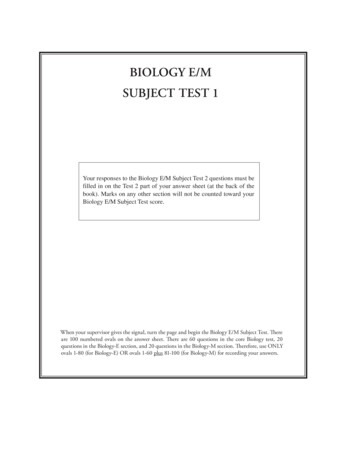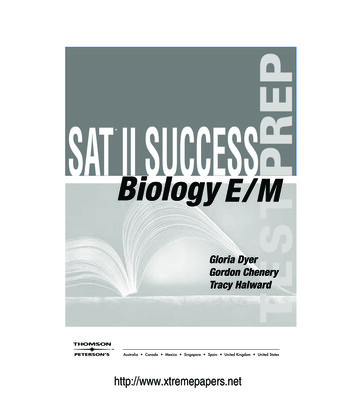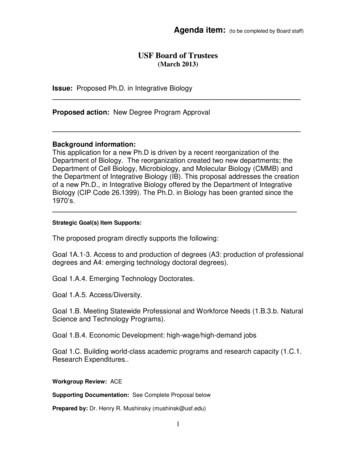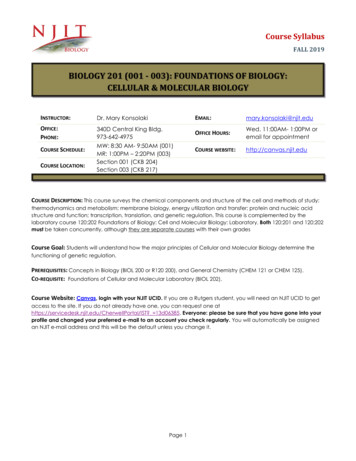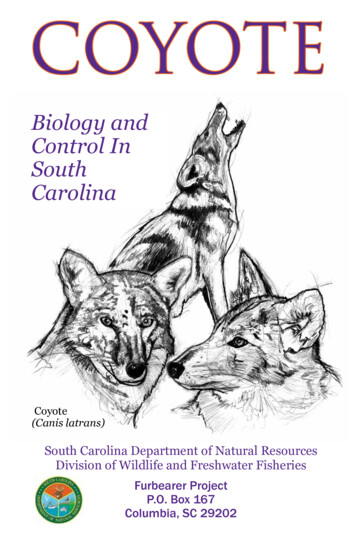
Transcription
COYOTEBiology andControl InSouthCarolinaCoyote(Canis latrans)South Carolina Department of Natural ResourcesDivision of Wildlife and Freshwater FisheriesFurbearer ProjectP.O. Box 167Columbia, SC 29202
FP Publication 20-02
ContentsBiology .2Appearance .2Distribution.2Habitat.3Feeding Habits.3Behavior.3Breeding.4Controlling Factors.4Status.5Damage Identification.6Control Techniques.7Non-lethal Control.7Exclusion.7Cultural Methods - Livestock & Rural Areas.8Cultural Methods - Suburban Areas.8Guard Animals.9Frightening Devices. 10Lethal Control. 10Toxicants. 10Shooting. 10Trapping. 11Coyote Foothold Trap System. 12Equipment. 13Trap Preparation. 13Coyote Trap Sets. 16Dirt-hole Set. 16Scent Post Set. 18Baits, Lures, and Urines. 20Checking Traps. 22Depredation Permits. 22Predator Management Permits. 22Obtaining Permits. 23Wildlife Control Operators. 23Coyote Trapping Equipment Checklist. 24
BIOLOGYAppearancefront21/2 in.front21/4 in.The coyote has the generalappearance of a small shepherdtype dog; standing 23 to 26inches at the shoulder with a slimmuzzle, erect pointed ears anda bushy tail. The fur is generallya grizzled, grayish-brown butvaries greatly from light tan orreddish-tan to almost black. Thetypical coyote weighs 30 to 45lbs., though coyotes more than60 lbs. have been recorded.hindcoyote trackshinddog tracksCoyote tracks are similar toother dog tracks; however a coyote’s tracks are usually longer than they arewide. Their tracks are usually more compact than dogs’, and their stride islonger, about 16 to 18 inches while trotting. Typical coyote tracks are 2 to 3inches long and 1 1/2 to 2 inches wide with the front heel pad being largerthan the rear and with the rear heel pad track usually small and circular inshape. Often, only the middle two claws will be present in the tracks.Coyote scat varies dependingon their diet. Often it is cigarshaped and may containbone, hair, berries and seeds.Coyote scat may also be nearlyformless and dark red toblack in color after feedingon larger animals. The mostlikely places to find coyotescat is along dirt roads, onridges, trails, near largerocks or prominent clumps ofvegetation. It is believed thatcoyote scat is often depositedto mark territories.National Park Service / Jacob W. FrankDistributionThough historically found in the western half of the United States, the coyoteis now found throughout North America due to range expansion and illegaltranslocation by houndsmen groups. Populations in South Carolina wereestablished in Pickens and Oconee counties in the late 1970s by bothhoundsmen and natural immigration. Coyotes have since expanded to includeall counties in the State. However, even if no illegal importation had taken place,coyotes would still have become established in South Carolina.2
Contrary to popular belief, the South Carolina Department of Natural Resources(SCDNR) did not import coyotes into South Carolina to control the white-taileddeer population, or for any other reason. This rumor also exists in otherstates as well, but considering the general belief among biologists duringthat period of time (that coyotes did not impact deer populations), it wouldhave made little sense to import coyotes. In addition, coyotes first appearedin the upstate, where deer reintroductions were still taking place at the time,as opposed to the Lowcountry where deer were plentiful.HabitatThough traditionally believed to be adapted to life in open areas, coyoteshave expanded into most types of habitats. While they do well in agriculturalcommunities, their relatively high tolerance for human populations allowscoyotes to exist in most areas of South Carolina. This includes mountainousregions, swamps, dense forests as well as suburban and even some urban areas.Feeding HabitsCoyotes are opportunistic feeders. While rabbits probably comprise themajority of their food/prey items, they also eat rodents and other smallmammals, and supplement their diet with fruits, berries, and insects whenavailable. They will eat carrion and will also prey upon deer fawns, andoccasionally on adult deer especially those with underlying health issues.Deer predation was not originally believed to be a significant factor for deerpopulations in South Carolina. However, studies at the Savannah River Site,located in Aiken and Barnwell Counties, have shown that coyote predationon fawns can impact recruitment, and fawns can be particularly vulnerableto predation for the first 6 to 8 weeks after birth. When coupled with humanharvest of deer by hunting, coyote predation on fawns appear to be anadditive source of mortality. While this study’s findings may not be uniformacross the entire state, it points to evidence that coyote predation can impactdeer fawn survival, and thus deer populations, at least in localized areas.Coyotes can also prey on domestic poultry and livestock, particularly sheep,goats and calves. Calf predation usually subsides after weaning. Cows givingbirth, especially animals having difficult births, can be susceptible to predation asthey usually separate from the herd while birthing. On occasion, coyotes will preyon domestic pets, especially cats. Pet predation is usually due to the territorialnature of the coyote and lack of an alternative prey base in suburban areas.BehaviorCoyotes are typically most active beginning at twilight and continuingthroughout the night. In some areas they may be seen during the day,especially when left undisturbed. Coyotes have a keen sense of smell andgood eyesight. They can reach speeds of 40 mph for short durations, thoughthey can sustain relatively high rates of travel over several miles.Resident, or territorial coyotes, typically have a home range from 2 to 20 squaremiles, with resident females occupying smaller ranges than males. Transientor solitary animals usually have much larger home ranges than resident3
animals, again with the males being larger than the females. Coyotes maymove several miles within their home range daily, and their movement activityusually peaks during the late winter breeding season. Resident animals willdefend their territory against transient coyotes.Coyotes usually hunt alone or in pairs and may travel over fairly large areasin search of food. Transient coyotes do not form packs, but residents formpack-like groups that may be seen occasionally. These packs are typically(but not always) related family members and may consist of a mated pair,non-breeding offspring from the previous year, and the current year’s pups.Coyotes have various calls, in addition to howling, that include yips andbarks. Typically, their vocalizations are used to communicate location or togather individuals together. Coyote vocalizations usually peak during thebreeding season, and vocalizations are generally more frequent duringclear nights with moderate temperatures. Often, loud noises from trains,airplanes or sirens will trigger coyote vocalizations.BreedingCoyotes are generally monogamous, with breeding among the dominantresident pair beginning in January and continuing into March. Subordinateanimals in a group with a dominant breeding pair typically do not breed.The gestation period is 63 days, and the average litter size is 5 to 7. Pupsbegin to leave the den at 3 to 4 weeks, are weaned at 8 to 9 weeks, andthe family breaks up permanently at 9 to 10 months as juveniles disperse.In areas where food is abundant, female young of the year may breed thefollowing winter. Both adults, and on occasion other adults linked with thebreeding pair, will hunt and bring food to their young. While raising young,coyotes will den in brush piles, banks, gullies, and old abandoned barns.Sometimes coyotes will den in burrows of other animals after enlargingtheir holes. Coyotes generally do not use dens except when rearing young,preferring to bed in tall grass and brush at other times of the year.Coyotes are capable of interbreeding with domestic dogs, but survival ofthe offspring is low. Typically, coydogs’ breeding cycles do not correspondto coyotes’, thus further breeding with coyotes is unlikely even thoughcoydogs may be able to reproduce.Controlling FactorsCoyotes are subject to canine distemper, parvo, hepatitis, mange, and rabies.Coyotes also harbor a variety of parasites such as fleas, ticks, worms, andflukes. The incidence of rabies in South Carolina coyotes is unknown, as fewanimals are submitted for testing. There is no routine rabies testing surveillancein the state, as animals are only tested when a potential exposure occurs.Incidental take from hunting activities, most notably deer hunting, comprisesmost of the yearly coyote harvest in South Carolina. Based on deer huntersurveys, hunters kill approximately 25,000 coyotes annually.4
Although western pelts may bring relatively high values from time to time, astrong market has not developed for the eastern coyote. However, it is legalfor a licensed trapper to sell live coyotes to fox and coyote running enclosuresduring the open trapping season.* Therefore, there is an incentive for sporttrappers to target coyotes. Some landowners have been able to coordinate withthe South Carolina Trappers Association to locate a local trapper that mightbe willing to trap on their property during the open trapping season. However,as nuisance coyote problems increase and become more widespread, thedemand for contract coyote control work should increase and the numberof coyotes taken from trapping by Wildlife Control Operators (WCOs) will rise.*Check current SCDNR Trapping and Commercial Fur Harvest laws and regulations.StatusCoyotes are considered furbearing animals in South Carolina; however,coyotes may be hunted throughout the year with a valid hunting license onprivate lands. The use of electronic calls is legal statewide, and coyotes canbe hunted at night on registered properties. Go to the SCDNR website’s NightHunting page at dnr.sc.gov/nighthunt to register a property to hunt coyotesat night. Laws and regulations may change, so check the current SCDNRHunting Rules and Regulations before hunting coyotes in your area.Individuals may trap coyotes during the trapping season (December 1 throughMarch 1) with a valid Commercial Fur Harvest license in addition to therequired hunting license. Check the current SCDNR Trapping and CommercialFur Harvest brochure for more information about trapping regulations.Depredation permits are available for controlling destructive coyotes yearround. No hunting or trapping license is required with a depredation permit.For more information about depredation permits, see the Depredation Permitssection in the back of this publication or contact the SCDNR Permitting Officeat (803) 734-3887.Coyotes and their associated damage are unpopular with livestock producersand sportsmen. Nevertheless, attempts in other states to eliminate or drasticallyreduce the coyote population on a large scale have proven unsuccessful.Various coyote incentive programs have been tried over the years throughoutthe United States, with the stated goal being to reduce or eliminate coyotes;however, there has been very little to show for these efforts in terms of positiveresults. In fact, even under the presence of paid bounties, the coyote spreadfrom its historical range in the west to occupy the entire continental U.S.Bounties for coyotes, while usually very popular, generally do not produceany appreciable effects, or at best are only temporary, leading most states toabandon paying coyote bounties. Since nearly 30,000 coyotes are taken annuallyin South Carolina by hunters and trappers, a bounty would likely only pay for aportion of the coyotes currently being harvested at no cost. Nevertheless, for abounty system to be successful, a significant number of additional animals overthe current harvest levels must be removed on an annual basis. Given currentliberal hunting and trapping regulations, the number of coyotes being removedunder these regulations, and the notion that people who want to control coyotes5
are already attempting to do so, it is highly unlikely that a paid bounty wouldadd appreciably to the number of coyotes in the annual harvest. Lastly, as withany monetary incentive, there is no guarantee that coyotes submitted wouldactually originate from South Carolina, as historically many bounty programshave been plagued with fraudulent bounty submissions.When necessary, it is possible to control coyote-related damage at the locallevel by targeting and removing the specific offending animals. If coyotes inthe area are not causing specific depredation problems, it is suggested theynot be removed merely because of their presence. Coyotes are territorial,and the removal of non-depredating coyotes may result in replacementwith coyotes that are more prone to cause problems.Attempting to control overall coyote numbers can be frustrating as newimmigrant animals often quickly fill the voids left from the removal of residentanimals. In addition, reproduction may actually increase from the removalof these resident coyotes with animals beginning to breed at younger ages,although reproduction still only occurs once annually and the overall fecundityof coyote populations with younger coyotes tends to be lower.Damage IdentificationIn case of suspected coyote depredation, the area should be searched fortracks, droppings or any other sign that might indicate a coyote’s presence.However, coyotes will scavenge dead animal carcasses; therefore, thepresence of a dead animal with coyote sign in the vicinity does not necessarilyindicate coyote depredation. Accurately determining coyote depredationinvolves carefully examining the carcass. Hemorrhaging just under the skinat the bite marks indicates the animal was alive when bitten; however, toothmarks under the skin without accompanying hemorrhage indicate the animalwas fed upon while dead. The surrounding area should also be investigatedfor signs of a struggle. Attacks on larger animals usually involve a longerduration of attack, and the adjacent area may have broken vegetation, dragmarks or scuffs, as well as blood and/or hair at the site of the kill.Typical coyote predation involves attacking the throat of the prey, thoughsome attacks on calves may be to the flanks or hindquarters. The presenceor absence of this predation pattern, however, does not necessarilyindicate coyote predation. Domestic dogs, which typically attack the flanks,hindquarters and heads of animals, will exhibit coyote predation patterns,while some coyotes may resemble that of domestic dogs. Often, domesticdogs will not feed on the killed animal, though true feral dogs and coydogsmay kill for food and be efficient predators. Only a thorough investigation ofthe kill and surrounding area may help determine the actual predator involved.Determination of predation can be a difficult task. The amount of evidenceat the site of the kill along with the amount of prey and the age of thecarcass are factors in assessing the source of predation. Usually, accuratedetermination of predation involves experience and a keen knowledge ofthe species of predators in the area. Even this acquired skill may not confirmthe cause of death in many cases.6
Control TechniquesNon-lethal ControlExclusionFencing, where practical, can deter livestock predation. Traditional barbedwire fences are not a deterrent to coyotes. However, certain woven wirefences can keep out coyotes if installed properly. Because coyotes can digunder most woven-type fences, it is recommended that an apron of fence beburied perpendicular to the fence for a width of two feet around the outside ofthe fence. Because of the expense, this type of fencing may only be feasiblefor pens and corrals. If a buried apron fence is too expensive or impractical,electrified wire near ground level may deter coyotes from digging under thefence. An electric wire at the top or a barbed wire overhang angled towardsthe outside of the fence may deter climbing over the fence.Another way to deter coyotes climbing over a fence is to install a length of PVCpipe using a larger diameter pipe over a smaller diameter pipe or conduit,or with a wooden end piece mounted inside the pipe that can be mountedon top of a fence to allow the outer pipe to spin (Figure 1.). As the animalreaches the top of the fence, the outer pipe rolls and prevents climbingover the top of the fence. This can also serve to keep pets inside the fence.Rollers are likely better suited to smaller yards or enclosures.Electric fences can also deter coyotes if the spacing between the wires is 8inches or less at the top and at least four strands at the bottom spaced 4 inchesor less. These fences should be at least 5 to 6 feet high. The addition of anoutside wire 8 to 10 inches out from the bottom of the fence and 6 to 8 incheshigh may greatly improve the effectiveness of an electrical fence.Existing fences can be modified to deter coyotes by attaching 3 to 4 strands ofelectric fencing 8 to 10 inches to the outside of an existing fence.Figure 1. Fence rollers at top of fence to prevent climbing7
It is important that all fencing be adequately maintained and in workingorder to ensure its effectiveness.Cultural Methods - Livestock & Rural AreasSome cultural methods can help minimize livestock loss to coyotes and otherpredators. Because of the high nutritional demands of bearing and raising pups,coyote predation may be highest from late spring to early fall. Changing calvingor lambing season outside of this time frame, or shortening or synchronizingthe birthing seasons may result in some reduction in livestock predation.Confinement of smaller herds of livestock at night can also reduce coyotepredation, especially in lighted predator-resistant fences.Some modifications to the surrounding habitat may also be beneficial toreducing coyote depredation. Coyotes often use cover to stalk their prey,and reducing the amount of cover near pastures may lessen predation.Furthermore, brush piles and heavy grass cover increase habitat for rabbitsand other small prey, thus attracting coyotes to the area. Cleanup or removalof this type of cover in some areas may also promote a reduction in predation.The dumping of livestock remains can attract coyotes and increase the chancesof livestock predation as coyotes could become accustomed to feeding onlivestock. Proper disposal of livestock remains may reduce coyote predation.Cultural Methods - Suburban AreasCoyotes that consume a significant proportion of human-related food itemsare more likely to become habituated toward people and cause negativeinteractions. These food items include pet food, garbage, and discardedfood scraps. Neighborhoods should encourage feeding pets indoors as wellas proper disposal of all trash. Food items used for composting should beplaced in sealed or closed bins.Coyotes are most active beginning near dusk and continuing into the earlymorning hours after dawn, so it is advisable to keep smaller pets inside atnight if possible. Cats should also remain indoors not only for their safety,but to reduce the negative impacts cats can have on native wildlife. All petsshould be fed during the day, and any food and food containers should beremoved before dark. A coyote’s sense of smell is excellent, and they can beattracted to the smell of pet food or even residual smells left by an empty bowl.People should walk their pets in more open areas that prevent a coyote fromambushing the pet. All pets being walked should be kept on a short leash. Ifa coyote is seen, act aggressively towards the animal, but do not run.Feral cat colonies can be problematic on many levels. However, thedeliberate feeding of a feral cat colony can attract coyotes, as well as otherwildlife, to the colony. This concentration of cats represents relatively easyprey to a coyote. Discourage the feeding of any stray cats or, at a minimum,require any remaining food to be collected before dark.8
Suburban and urban coyotes tend to utilize parks and natural areas morethan places with less green space. Developed communities with significantamounts of green space can modify the habitat to make the area lessattractive for coyotes. Undeveloped lots and common areas should bemanaged to keep underbrush and overgrown areas to a minimum. Not onlydo these areas provide travel corridors, but also provide denning, hiding andambush sites for coyotes. In addition, brushy and overgrown areas providehabitat for small mammals which are a primary food source for coyotes.Opening up overgrown areas can help discourage coyotes from remainingin these places, especially during daylight hours.Parks and recreational areas should prohibit the feeding of wildlife. Visitorsto these areas must not be allowed to feed wildlife, and the proper disposalof all refuse must be enforced. Leash laws should also be enforced to helpprevent pet attacks or any other coyote and dog confrontations.Coyotes should never be allowed to become habituated to people. Whencoyotes are sighted, especially in daylight hours, every effort should be madeto harass and run the animal off. It is necessary to keep coyotes fearful ofpeople to prevent negative coyote behavior.If coyote sightings become more frequent and confrontations with people andpets begin to occur, such as chasing joggers, bicyclists, or people walkingpets, it is a sign that coyotes are beginning to lose their fear of humans.When this occurs, the potential for some type of negative coyote encounterincreases. Coyotes that exhibit aggressive behavior should be removed by aprofessional trapper. The SCDNR maintains an online list of Wildlife ControlOperators that perform wildlife removal services, usually for a fee. See theWildlife Control Operators Section on page 23.Guard AnimalsCertain animals such as donkeys, mules, llamas, emus, ostriches, andcertain breeds of dogs have some promise in reducing coyote predationfor livestock producers. Research has shown guard dogs to be particularlyeffective at reducing livestock damage, especially when the dogs are rearedwith the livestock from a veryearly age. Great Pyreneesdogs are probably the mostcommonly used livestockprotection breed in SouthCarolina. Donkeys and mulesmay also have value as guardanimals for sheep and goats.For more information aboutguard animals, contact theUnited States Departmentof Agriculture’s WildlifeServices office listed in theback of this booklet.Great Pyrenees dog with goats at a farm in Princeton, SC.9
Frightening DevicesThe use of frightening devices may temporarily reduce coyote predation. Lightsover corrals have been shown to be effective. Parked cars, strobe lights, andnoise-making devices may have some value in deterring coyotes for very shortperiods of time. Varying locations and/or intensity is important as coyotes canquickly become habituated to such techniques. The effectiveness of frighteningtechniques may be very limited.Lethal ControlToxicantsNo toxicants are registered for use on coyotes in South Carolina. The use of anypoison to control predators in South Carolina is a violation of State and Federallaw. Nevertheless, coyotes can become accustomed to avoid poisoned baits andthe use of illegal poisoning is more likely to affect nontarget wildlife and pets.ShootingShooting coyotes to control predation can be effective in certain situations,and may be the only viable alternative for individuals inexperienced oruncomfortable with trapping.Coyotes have a keen sense of smell; therefore, shooting locations should beselected so as to remain downwind from the area where coyotes are likely toapproach. Smaller caliber centerfire rifles, where safe and legal to use, arecapable of killing coyotes at relatively long ranges. A shotgun may be desirablewhen attempting to shoot coyotes at close range or in heavier cover types. Usuallythe smaller sizes of buckshot, such as #4, are preferred over the larger sizes.Coyotes can be attracted through the use of predator calls, though the exclusiveuse of calling to control coyote depredation may not be successful, as they maybecome wary of repeated attempts to call and shoot. Usually the first few hoursafter sunrise and before sunset are the most effective times to call in coyotes.Even the imitated sound of a howl may attract a coyote, though the animal mayapproach without responding. Electronic calls with a wireless remote controlmay be more effective as the calls originate away from the hunter’s location.Remote motion decoys may also increase the effectiveness of using predatorcalls. Night hunting is allowed on registered properties with the owner’spermission. See dnr.sc.gov/nighthunt to register a property for night hunting.*Locating den sites may aid in removing coyotes, especially during the pup-rearingseason, as the pups may trample vegetation just outside of the dens whenbeginning to venture out. This may make locating den sites easier.In certain areas, the use of dogs to pursue coyotes and bring them into therange of shooters may be somewhat effective.*Check the current SCDNR Rules and Regulations brochure in regards to hunting or shootingcoyotes as well as the current night hunting regulations.10
TrappingTrapping is probably the most effective tool for removing problem coyotes. However,the coyote’s wary nature and keen sense of smell can also make them one of themore difficult furbearing animals to trap. Inexperienced trappers or poor trappingtechniques may help educate coyotes to avoid traps and become “trap shy.”The normal trapping season is December 1 to March 1. A CommercialFurharvest License, commonly called a trapping license, is required alongwith a hunting license to trap during the season. However, property ownersexperiencing coyote-related damage may trap or shoot (in areas where firearmsmay be lawfully discharged) coyotes within 100 yards of their residence (so longas they are still on their own property or an adjacent property with landownerpermission) without any kind of license or permit. Outside of this 100 yardresidential area, a permit or trapping license (during the trapping season)would be required (see Depredation Permit section on page 22).It is suggested to wear rubber boots and clean gloves while preparing thetrap site to minimize human odor to the best extent possible. Removegloves when applying any scent or lure so as not to get any on the traps orequipment, which might prompt a coyote to dig up the trap.Selecting a proper trap site is key to determining whether or not trapping will besuccessful in controlling problem coyotes. It’s important that traps are placedin areas where coyotes are traveling or frequenting. Preferably, place trapswhere scent will travel in the direction coyotes are likely to approach. Dirt road,trail, dam, stream, and fence crossings as well as field corners and borders,hedgerows, brush piles, isolated hay bales, or other prominent propertyfeatures are all good areas to look for coyote sign, such as tracks or droppings.Coyotes, just like domestic dogs, will urinate on objects that stand out, suchas fence posts, large rocks and other distinctive land features. Trappers canuse this behavior to their advantage by trapping at these “scent posts.”Traps may also be successful if placed on trails near areas where livestockhave been killed. Keep traps at least 50 feet away from dead animals oranimal parts to avoid catching vultures or other nontarget animals.Only foothold traps, with an inside jaw spread of 5 ¾ inches and smallerare legal for use on coyotes in South Carolina. Live traps are legal for use,though generally not very effective for coyotes. However, certain suburbanand urban settings may require their use. Because a trap is defined in SouthCarolina as “any device, other than a weapon, designed or constructedfo
Contrary to popular belief, the South Carolina Department of Natural Resources (SCDNR) did not import coyotes into South Carolina to control the white-tailed deer population, or for any other reason. This rumor also exists in other states as well, but considering the general belief among biologists during

